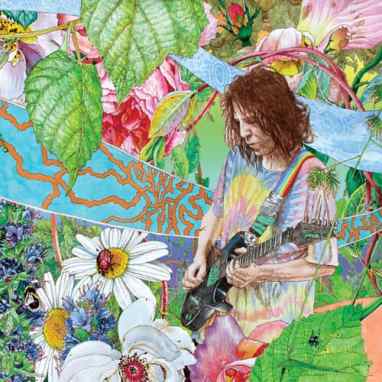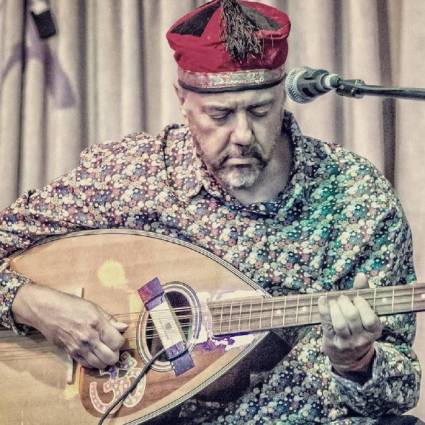
Facelift fanzine was renowned for trying to sneak in Ozric Tentacles reviews at every opportunity, regardless of their tangential links to the ‘scene’ (there are links both musically and personnel-wise if you’re prepared to look hard enough) and I’ve followed the progress of this seminal space-rock band assiduously over the last thirty years. As their leader Ed Wynne re-located back to the UK following a number of changes in circumstances, I was lucky enough to catch him at Kozfest in 2017 firstly as a guest with the Ullulators, then memorably with his own pop-up band as most of the initial Ozrics line-up were re-united for a superb hour long jam.
But any assumption based on these good vibes that this would naturally morph into Ozrics mark z appears to have been misplaced. Instead Ed has been working for a while on his first solo album, whose appearance was initially slated for September but eventually appeared in January. What’s perhaps surprising, given the extraordinary diversity in the early Ozrics tapes both in terms of Ed’s choice of stringed instruments and a heady mix of styles, is that ‘Shimmer Into Nature’ seems to continue the homogenous path of recent band albums, most notably the admittedly excellent double ‘Technicians of the Sacred’. The music is incredibly dense, a blend of busy programmed drums, undulating bass parts and layers of keyboards, with an initial impression that there may not be sufficient space to showcase trademark guitar work.

Despite myself living so remotely in the nether regions of West Yorkshire that running water is considered to be something of a luxury, I happen to live 3 doors down from a fellow Ozrics aficionado, and when I mentioned to him that I was finding it difficult to find a hook in to ‘Shimmer’ he sagely advised me to ‘stick with it’. And he was right: it’s a slow burner, and beyond the density are all the hallmarks of an Ozrics archetype: titles such as ‘Oddplonk’ and ‘Wherble’ and ‘Shim’ suggest the band’s legacy of slightly absurdist track names is safe – and indeed these final three tracks, each clocking in at around 10 minutes, are the album’s best. Whilst ‘Shim’ is the most instantly recognisable classic based on a superb keyboard theme, ‘Oddplonk’ is probably the best, with, eventually, all the trademark elements: the rolling bass theme, the initial guitar riffing, the swirling, bubbling keyboards, the joyful guitar solo which eventually morphs into the distorted, reedy lead line doubled by further rhythm lines. There are even the ‘Jurassic Shift’ type harmonics in there, and it almost takes me back to the semi-jammed delights of ‘Tantric Obstacles’.
In fact, from what appears initially as a predominantly synth and programmed led album, guitar reveals itself more and more, with further fine riffs on ‘Wherble’. One month on, this album still continues to give, and I’m fairly sure I’ve not finished with it yet. With the news that the spring Gong tour will be backed by support from the Ed Wynne band, this seems like a nice way to finish this particular batch of reviews. Given that the only misgivings I have about this album is a tendency to build a multitude of layers to the detriment of the ‘space’ which allows Ed Wynne’s guitar to shine at its brightest, perhaps the adding of ‘real’ bass and drums will complete a comfortably heady mix to everyone’s satisfaction.





 This unexpected release emanates from two different strands of current Canterbury music and also appears in an unexpected format – 21 minutes of spontaneous composition on vinyl. I’d heard of (and eventually heard) a version of ‘Facelift’ performed by this outfit doing the rounds, but confusingly credited (at least in part) to Syd Arthur. For all their wonderful repertoire, complex compositions, psychedelic credentials and a nod to the classic carefree feel of early Caravan I would not have associated Syd Arthur with the kind of extended workout afforded to either that track or what we have here.
This unexpected release emanates from two different strands of current Canterbury music and also appears in an unexpected format – 21 minutes of spontaneous composition on vinyl. I’d heard of (and eventually heard) a version of ‘Facelift’ performed by this outfit doing the rounds, but confusingly credited (at least in part) to Syd Arthur. For all their wonderful repertoire, complex compositions, psychedelic credentials and a nod to the classic carefree feel of early Caravan I would not have associated Syd Arthur with the kind of extended workout afforded to either that track or what we have here.



 WillemJan Droog is a Dutch keyboard player with a long association with Phil Miller, the most recent evidence of which was with the Relatives, the band which also featured Jack Monck (of Delivery) and Marc Hadley. The band recorded ‘Virtually’, reviewed
WillemJan Droog is a Dutch keyboard player with a long association with Phil Miller, the most recent evidence of which was with the Relatives, the band which also featured Jack Monck (of Delivery) and Marc Hadley. The band recorded ‘Virtually’, reviewed 






